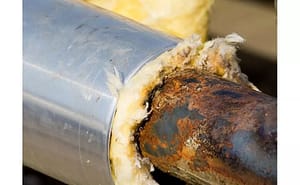Four Best NDT Methods for Corrosion under Thermal Insulation
Four Best NDT Methods for Corrosion under Thermal Insulation – many literatures and data have proved that Cui is a very common and complicated phenomenon, and it is very difficult to find this kind of corrosion, and it needs a lot of time and economic cost.
The corrosion under insulation layer is the corrosion phenomenon of pipeline or equipment covered by insulation layer due to the entry of water and corrosive substances.
This corrosion is usually hard to detect because it is usually hidden under an insulating layer, traditionally detected by:

- Remove pipe surface coverings;
- Check the pipes;
- Restore the original appearance of the surface coverings.
This process involves a lot of cost and logistical issues. Even cutting the cladding alone is a very time-consuming and labour-intensive process, which may be further complicated if the covering material contains asbestos and needs to be safely removed.
There are many kinds of nondestructive testing techniques suitable for corrosion under insulating layer, but most of these techniques can be effectively detected only in the case of obvious leakage of fluid. Of course, the industry needs more technology that can be tested without removing the insulation. Usually, these methods are not used alone, but will be combined with each other, play to their respective strengths and make up for their shortcomings, to achieve the best detection results.
Visual Testing
Visual testing is the simplest and most obvious method, which involves removing the covering (in part or in whole), visually checking the surface for signs of corrosion or damage, and then deciding whether the insulation needs to be replaced. This method is very effective, but the disadvantage is that the cost is high, engineers can generally only inspect the external area of the pipeline, can not inspect the internal space of the pipeline. The removed insulation may also need to be replaced, adding additional economic costs. Moreover, the entire inspection process must be done carefully and appropriately, or the integrity of the pipeline structure may be compromised, as well as other additional risks.
Radiographic Testing
Radiography is another common method for detecting corrosion under thermal insulation. This x-ray technology can be subdivided into many different technologies, such as real-time radiography (RTR) , computer radiography (CR) and digital detector array (DDA) . Each approach has different advantages and disadvantages, and its applicability depends on the specific application. For example, the computer radiography instrument is only suitable for both sides of the detection component, while the digital detector array instrument, although more accurate and less distorted image, but due to structural constraints, its performance generally decreases with the increase of pipe diameter.
Ultrasonic Thickness Measurement
Ultrasonic thickness measurement is a high-efficiency, high-precision, multi-purpose remote visual detection technology, which is widely used in many industries. It works on the principle of ultrasonic transmission, can be measured through a variety of lining and coating wall thickness. Another advantage of this technique is that it only needs to measure one side of the component under test.
Pulsed Eddy Current Testing
The pulsed eddy current (PEC) technique uses electromagnetic wave techniques to determine the wall thickness of any conductive material. This method does not need to contact the probe with the test surface, but still has high accuracy. However, because the technique provides only average wall thickness, it is usually used only as a screening technique and is not used to detect isolated corrosion areas. In addition, pulsed eddy current technique can only be used in the detection of carbon steel and low alloy steel structures, which limits its application.
Learn more our project quality managemet, QAQC and third party inspection (TPI), NDT practices thru below link.-
